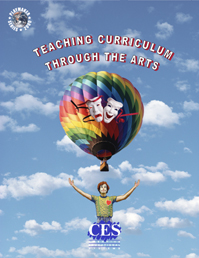Contents:
"Teaching Curriculum Through the Arts"
 This book presents a methodology to create an optimal learning environment through which one of the most powerful teaching strategies, the application of the visual and performing arts to curriculum study, may be utilized by teachers and students alike. This teacherís manual introduces the concept of arts-in-education and its application to teaching any K-12 curriculum subject for the uninitiated classroom teacher. It begins with an emphasis on those qualities any student must acquire throughout his or her educational career in order to become an active, enthusiastic, and confident learner; e.g., self-esteem, cooperation, an in-depth understanding of curriculum information,
communication skills, creative problem solving, discipline control and self expression. It proceeds to then define arts-in-education and demonstrate through 75 focused classroom activities how students may systematically develop those qualities through the use of the literary, visual and performing arts applied to Language Arts, Social Studies, Science and Mathematics.
This book presents a methodology to create an optimal learning environment through which one of the most powerful teaching strategies, the application of the visual and performing arts to curriculum study, may be utilized by teachers and students alike. This teacherís manual introduces the concept of arts-in-education and its application to teaching any K-12 curriculum subject for the uninitiated classroom teacher. It begins with an emphasis on those qualities any student must acquire throughout his or her educational career in order to become an active, enthusiastic, and confident learner; e.g., self-esteem, cooperation, an in-depth understanding of curriculum information,
communication skills, creative problem solving, discipline control and self expression. It proceeds to then define arts-in-education and demonstrate through 75 focused classroom activities how students may systematically develop those qualities through the use of the literary, visual and performing arts applied to Language Arts, Social Studies, Science and Mathematics.
CHAPTER ONE:
What is Arts-in-Education?
The relationship between the principles, processes and techniques of the arts to the exigencies of classroom management and the necessities of sequenced instruction. Included: the key principles of making intellectual and emotional connections between disparate facts and holistic understanding; managing the chaos of right-brain creativity by using left-brain organizational skills; and teaching students to effectively deal with both "failure" and "success" through the concept of experimentation."
CHAPTER TWO:
Creative Drama
The use of traditional creative drama techniques to nurture studentsí imagination and to give them the opportunity to make their own choices in constructive "role play" situations. Includes: improvisation techniques, theatre games, developing oneís own arts-in-education activities, the individual creation of poems, playmaking, and the performing and production basics thereof.
CHAPTER THREE:
The Arts as Teaching Strategies
How to make the connections between creative drama techniques and the teaching of curriculum objectives (through relevant classroom activities) in language arts, social studies, science and mathematics. Included: an interdisciplinary approach to life in Ancient Greece, the uses of the essential elements of creativity (space, time, light, movement, color, line, shape, form, sound, pattern, rhythm and texture), the development of a creative classroom, i.e., providing an environment that honors the elements of creativity, nurtures the creative process, and celebrates the creative act; and activities designed to understand and use both word and picture symbols as representative of thoughts and feelings.
CHAPTER FOUR:
Designing the Arts-Based Thematic Curriculum
This chapter deals with the subject of how a teacher can teach her entire curriculum through the arts. Included: how to create an interdisciplinary, thematic curriculum by developing a central focus based on a piece of core literature or about an historical period; the use of a curriculum wheel with which to extrapolate from that central focus to lessons that include all curriculum areas; the theatricalization of non-dramatic material; applications of Howard Gardnerís Theory of Multiple Intelligences with relevant exercises, including the improvement of writing skills.
CHAPTER FIVE:
Artists in the Classroom
The effective utilization of professional teaching artists (poets, actors, dancers, musicians and visual artists) who are hired by schools as master teachers of arts disciplines to expose students to their unique experiences and techniques they have developed in creation of works of art. Includes: the arts residency from both the classroom teacherís and the artistís perspectives; recommendations (doís and doníts) and guidelines for both artist and teacher to blend their respective knowledge to co-create an effective arts-in-education experience for the highest good of all concerned; five levels of arts residency in the classroom; and the benefits to teachers of professional development in the arts.
Also included in Teaching Curriculum Through the Arts are: CES principles of educational and artistic philosophy, educational strategies and their rationales, bibliography, stories to dramatize in the classroom, a selected list of musical compositions for background music, arts-in-education resources, and index. List price: $17.95
To order, Click here!
Click here to go see the Student Workbook
accompanying this arts-in-education teachers manual.
Home
* More Books & Plays
* Arts-in-Education Programs
*
Contact Us
|

